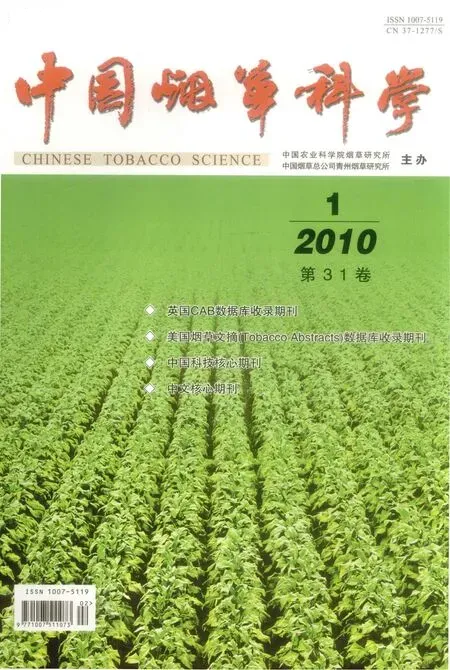科技期刊论文写作系列讲座:V.引言
2010-02-12张久权
张久权
(中国农业科学院烟草研究所 青岛 266101)
引言,又称前言、概述、绪论等,是论文主体部分的开端,它向读者交代本研究的来龙去脉,引导读者阅读和理解全文。引言的内容应包括:本研究工作的背景;相关领域前人研究的历史、现状、知识空白(如结论存在矛盾等);研究目的、理论依据、所作假设、要解决的问题、目的意义等。撰写引言时,要注意以下几点:
(1)引言的篇幅大小虽无硬性的统一规定,但不宜太长,要精炼,突出重点,一般应控制在1000字以内;
(2)摘要已经交代清楚的内容,在引言里不要重复;
(3)不要描述同行熟知的、教材上能找到的基本理论或知识;
(4)在回顾前人的研究时,不需要面面俱到,应引用“最相关”的文献以指引读者,优先引用相关研究中经典、重要、最新和最具说服力的文献。如果作者没有引用最重要的相关文献,或者不恰当地大量引用作者本人的文献,将会使整篇文章的价值大打折扣。
(5)图、表、公式等在引言中不宜列出;
(6)对不常用的专门术语或缩写词,进行解释或定义,以帮助编辑、审稿人和读者阅读稿件;
(7)引言的关键在最后部分,即要明确地陈述该研究的目的和假设。读者在阅读后面的内容时,会思索作者是否最终达到了预期的目的,假设是否成立?以什么研究材料和研究方法来验证这些假设?逻辑结构上是否合理?这将是整个研究是否科学、严谨的核心。
下面是2006发表在美国农学杂志Agronomy Journal (SCI刊物)上的一篇文章的引言,文章题目为:Boron Fertilization Influences on Soybean Yield and Leaf and Seed Boron Concentrations,供大家参考。为了节省篇幅,将参考文献引用格式改成了数字标注式。
Boron is an essential micronutrient for plants.Some plants are more susceptible to B deficiency and toxicity than others.Soybean is considered relatively insensitive to B deficiency[1-2].However, research with soybean has reported negative, positive, or no yield responses from direct applications of B fertilizer[2-8].Oplinger et al[9]reported that 0.28 kg B ha-1applied foliarly numerically increased soybean yields by 3% when averaged across 29 trials conducted on B-sufficient soils in the Midwest.Individual trial results usually showed no significant differences among yields between the unfertilized control and soybean receiving B.Touchton et al[10]noted that soybean yield responded positively and nominally to B fertilization at three of nine site-years in Georgia and suggested that environmental conditions probably influence whether soybean responds positively or not at all to B fertilization.Although environmental conditions may play an important role in soybean response to B fertilization,soybean leaf B concentrations reported by Touchton et al[10]were sufficient (.25 mg B kg-1).Soil chemical (e.g.,soil pH and organic matter content) and physical (e.g., texture) properties also influence B availability to plants and have likely contributed to the inconsistent soybean response to B fertilization[11].
In Arkansas, before 2001, B was not recognized as a growth- or yield-limiting nutrient for soybean production, and no recommendations for B fertilization of soybean were available to growers.In 2001, Bdeficiency of soybean was first diagnosed in several counties in northeast Arkansas[12]and has been observed every year since, making it the most common nutrient deficiency of soybean reported in Arkansas.The soybean-producing areas of Craighead, Cross, Greene, Jackson, Lawrence, Poinsett, Randolph, St.Francis, and Woodruff counties that are west of Crowley’s Ridge produce about 403000 ha of soybean annually[13], which accounts for roughly one third of the Arkansas soybean production area.A large portion of the Arkansas soybean hectarage is irrigated with ground water high in Ca and Mg bicarbonate, rotated with flood-irrigated rice (Oryza sativa L.), and grown on siltloam soils that have low organic matter, low clay content, alkaline soil pH, and shallow topsoil, all of which have been recognized as soil conditions conducive to B deficiency[14].Boron deficiency symptoms have been observed 4 to 6 wk after soybean emergence during vegetative growth and during reproductive growth.The only published record of B fertilization field research with soybean in Arkansas was made by Al-Molla[15], who reported a 15% yield increase from the application of granular B at the R1 soybean stage[16]in Poinsett and Craighead counties.
Several studies have reported that soybean[8], cotton (Gossypium hirsutum L.)[16], peanut (Arachis hypogaea L.)[17], and alfalfa (Medicago sativa L.)[18]yields may respond positively to pre-plant incorporated or postemergence foliar applications of B.Boron application rate, rather than application strategy, seems to be the most important factor determining the response of crops grown on B-deficient soils.Compared with the unfertilized control, Touchton and Boswell[19]reported that soybean yields were increased from 0 to 4% from application of 0.28 to 1.12 kg B ha-1and reduced by 6 to 10% from 2.24 kg B ha-1.Woodruff[20]reported that soybean yields at one site were 77% greater than the unfertilized control when 0.56 kg B ha-1was applied to the soil from the V4 to V8 growth stage.The trifoliate leaves of the unfertilized control contained only 10 mg B kg-1,which is below the critical level of 20 mg B kg-1[21].The literature suggests that soybean with low tissue B concentrations (,20 mg B kg-1) generally respond positively to B fertilization and that B fertilization of soybean with sufficient concentrations of tissue B may have no benefit, slightly increase, or may reduce soybean yields.Much of the B fertilization research conducted with soybean has examined B fertilization for the purpose of increasing soybean yield potential by increasing branching[22], pod set[23-24], and various physiologic processes that may contribute to higher seed yields[23],especially for soybean grown in high-yielding environments[8].Preventing B deficiency has not been cited as a primary reason for studying B fertilization of soybean, presumably because widespread B deficiency of soybean, similar to the recent occurrence reported in Arkansas[25], is uncommon.Because B deficiency of soybean in Arkansas often occurs before the onset of reproductive growth and tissue B concentrations of soybean grown in northeast Arkansas are often low[26], research-based B fertilization recommendations are needed to assess the proper timing and rates of B application for preventing significant seed yield losses.The objective of these field studies was to determine the effects of foliar B application time and rate on soybean growth, B concentration in trifoliate leaves and seed, and grain yield.We hypothesized that (i)soybean yields would increase with B fertilization, (ii) B applied during early vegetative growth would increase soybean yield more than B applied during early reproductive growth on B-deficient soils, and (iii) increasing B rate would increase leaf and seed B concentrations.
